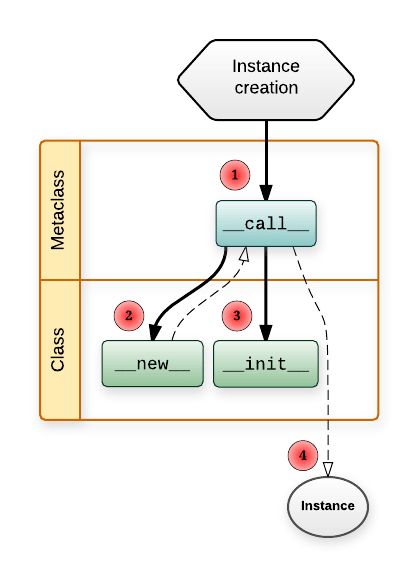Metaclasses in python are a way of supporting metaprogramming. Python has built-in metaclasses and also supports creating custom metaclasses. Understanding metaclasses in python helps to understand under the hood of classes and objects in python.
In python, to get the instance of or type of or class of an object, there are two ways → accessing __class__attribute of the object and calling type(obj)function. Both return the same value in new-style classes. Old-style classes before 3 have a different result for those though
So in python, we can refer to the object's type and it's class interchangeably. Everything in python is an object. If so, then a class should also be an object. Then what is the type if the class object or what is the parent class of class object? We will use type() to find the type of or class of the class object
class Foo:
pass
x = Foo()
type(x) // <class '__main__.Foo'>
type(Foo) // <class 'type'>
As shown in the code above type(x) will print <class '__main__.Foo'>because x is of type Foo or x is an object of class Foo. But the type(Foo) prints <class 'type'> which say the Foo is of type type. Foo is an object of type class. Not only the user-defined classes, but all the built-in classes will also have the same result which is <class 'type'>. And again as mentioned, all classes are instances/objects of type class, then type class should also be an object of a class which is type itself. In the short, the class of or parent class of typeclass is type itself. And this type is called a metaclass. How classes are created with metaclass type? Using the type function. The type function when passed a single argument, returns the type of the argument. The same function can also be used to create a class dynamically as below.
class Foo:
pass
Bar = type('Bar', (Foo,), dict(attr=100))
The above code creates a new class named Bar, inheriting from base class Foo
Let see what those argument are. The syntax is type(<name>, <base classes>, <attibutes>)
<name>: the name of the class to be created.
<base classes>: a tuple object of all classed to inherit from.
<attibutes>: a dictionary object of all the attributes to be added to the created class.
Instance(class and object of class) creation flow
Knowing the flow of instance creation helps understand metaclasses better.
Creating a class instance which is basically creating objects from classes can be depicted from the below diagram
The diagram is more self-explanatory. The flow is
- When a new object for a class is created, the
__call__method of the metaclass is called. In this case, the metaclass will betype - The call method calls the
__new__method of the class. This is the method which creates an instance and returns it to the__call__method - Then the
__init__method of the class is called with the created instance as the first parameter. - Then the instance is returned from the
__call__method
Not let us look at the creation of an instance of a metaclass which is creating a class itself.

Let's see the flow
- Initially,
__prepare__method is called which can return a dictionary that will be used as a local namespace in the created class. -
Meta-metaclass, which is in normal cases thetypeclass__call__method is invoked, which calls__new__method of the metaclass. This is where the class object is created and returned. - Then the
__init__method is invoked with created class a first parameter - Once
__init__returns, the created class is returned







Top comments (0)